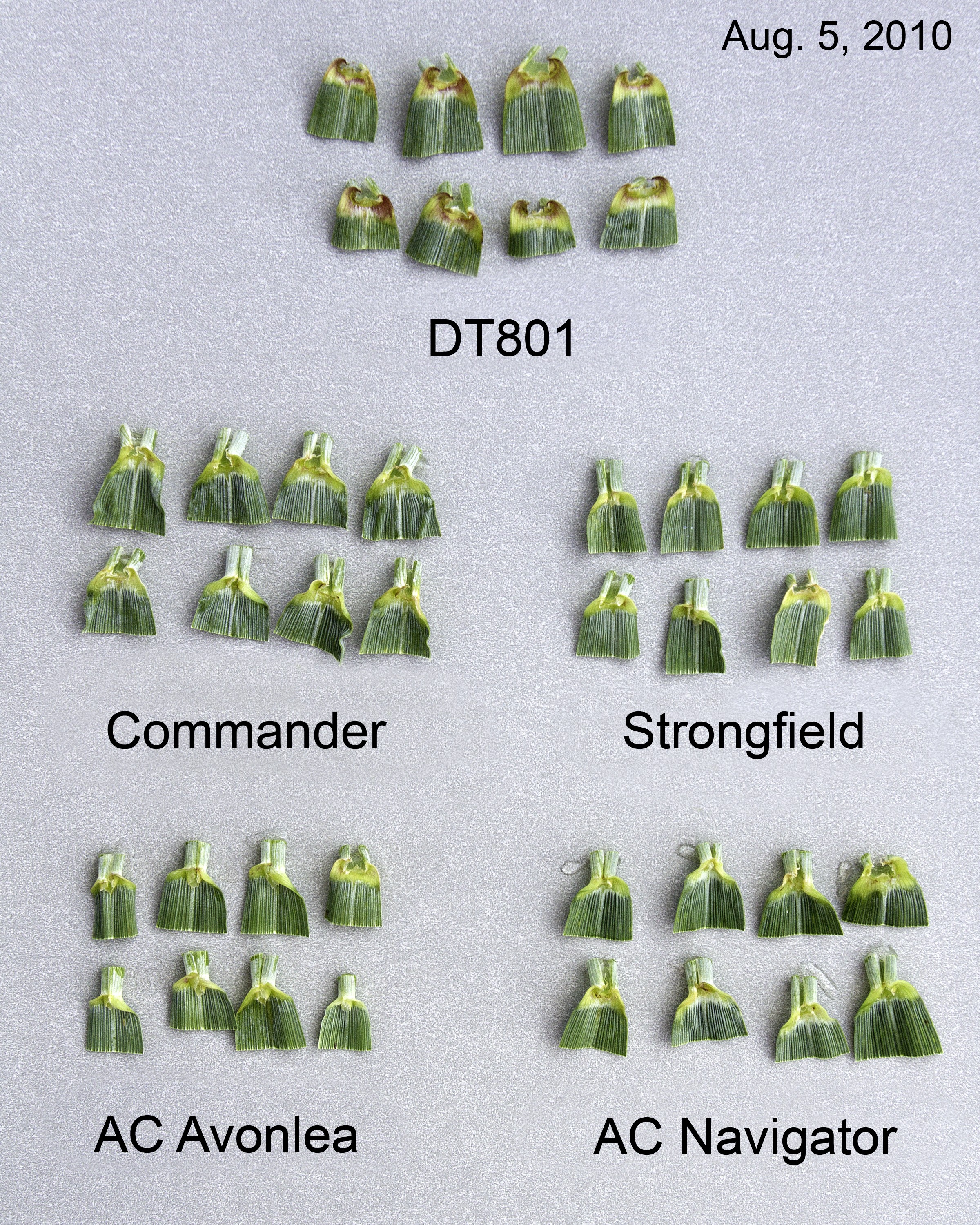Transcend
| Denomination: | 'Transcend' |
|---|---|
| Previously Proposed Denomination: | 'DT801' |
| Botanical Name: | Triticum turgidum subsp. durum |
| Applicant/Holder: |
Agriculture & Agri-Food Canada, Swift Current Research and Development Centre 1 Airport Road P.O. Box 1030 Swift Current, Saskatchewan S9H 3X2 Canada |
| Breeder: |
Asheesh K. Singh, Agriculture & Agri-Food Canada, Swift Current, Saskatchewan |
| Agent in Canada: |
Agriculture & Agri-Food Canada Office of Intellectual Property and Commercialization 107 Science Place Saskatoon, Saskatchewan S7N 0X2 Canada Tel: (306) 203-1383 |
| Application Date: | 2010-06-30 |
| Application Number: | 10-7018 |
| Grant of Rights Date: | 2012-09-06 |
| Certificate Number: | 4403 |
| Grant of Rights Termination Date: | 2030-09-06 |
Variety Description
Varieties used for comparison: 'AC Avonlea', 'Commander', 'AC Navigator' and 'Strongfield'
Summary: The intensity of anthocyanin colouration of the flag leaf auricles of 'Transcend' is weak to medium whereas it is very weak on the reference varieties. 'Transcend' heads later than 'AC Avonlea' and 'Strongfield'. The plants of 'Transcend' are taller than those of 'Commander', 'AC Navigator' and 'Strongfield'. Straw pith in cross section of 'Transcend' is thin whereas it is medium thickness in 'Commander' and 'AC Navigator'. The spikes of 'Transcend' are longer than those of 'Commander', 'AC Navigator' and 'Strongfield'. The awns of 'Transcend' are light yellow whereas they are black on 'Commander' and 'AC Navigator'.
Description:
PLANT: durum spring wheat, erect growth habit, low to medium frequency of plants with recurved flag leaves, matures mid-season
SEEDLING (4-leaf stage): very strong intensity of anthocyanin colouration of the coleoptile, glabrous sheath and blade of the lower leaves
FLAG LEAF: weak to medium intensity of anthocyanin colouration of the auricles, medium to strong glaucosity of the sheath, glabrous blade and sheath
CULM/NECK: medium to very strong glaucosity, straight at maturity
SPIKE: strong to very strong glaucosity, tapering, dense, light brownish-yellow at maturity, erect attitude at maturity, sparse hairiness of convex surface of the apical rachis segment
AWNS: present, awns longer than length of spike, light yellow at maturity
LOWER GLUME: narrow shoulder, ranging from sloping to elevated shape of the shoulder, medium length and width, glabrous
LEMMA: slightly curved beak
STRAW AT MATURITY: thin in cross section, no anthocyanin colouration at maturity
KERNEL: durum, amber, medium to large in size, elliptical, angular cheek, short brush hairs, medium to large-sized oval germ, medium width and medium depth crease
AGRONOMIC CHARACTERISTICS: good resistance to shattering, fair tolerance to drought and pre-harvest sprouting, good pasta quality
DISEASE REACTIONS: resistant to Leaf rust (Puccinia triticina), Stem rust (Puccinia graminis f. sp. tritici) and Common bunt (Tilletia caries, Tilletia foetida), susceptible to Loose smut (Ustilago tritici) and moderately susceptible to Fusarium head blight (Fusarium graminearum) and Leaf spot (Pyrenophora tritici-repentis, Dreschlera tritici-repentis and Phaeosphaeria nodorum, Stagonospora nodorum)
Origin & Breeding History: 'Transcend' (experimental name 'DT801') was selected from the cross DT707/DT696 made in 2001 at the Semiarid Prairie Agricultural Research Centre, Swift Current, Saskatchewan using a doubled haploid technique using the wheat-maize pollen system. In 2002, 799 doubled haploid genotypes from the original cross population were grown near Swift Current in 5 foot rows under irrigation. Of these, 466 genotypes were selected for plant height and lodging and grown as single rows in a winter nursery near Leeston, New Zealand in 2003-2004. Based on plant height, maturity and straw strength, 351 double haploid genotypes were selected and whole row harvested as seed source for agronomic trials in Canada. In 2004, these selections were grown under dryland conditions in four prairie locations. Forty-two doubled haploid genotypes were selected based on agronomic performance, disease resistance and quality characteristics. From these, one line, A0132&AV044, was grown in 2005 in 5 prairie locations. The doubled haploid genotype A0132&AV044 was selected for agronomic performance, disease resistance, grain cadmium concentration and quality. Disease reactions were assessed in hill plots at various locations throughout the Prairies. A0132&AV044 was tested in the Durum-B test in 2006, and from 2007 to 2009, it was tested in the Durum Cooperative Test as 'DT801'. The 105 breeder lines originate from 144 plant rows grown in 2008, which had originated from space planting in 2007.
Tests & Trials: Tests and trials were conducted during the summers of 2009 and 2010 at the Agriculture & Agri-Food Canada SemiArid Prairie Agricultural Research Centre, Swift Current, Saskatchewan. Plots consisted of 4 rows, with a row length of 3 metres and a row spacing of 23 cm. There were 4 replications arranged in randomized complete block design.
Comparison tables for 'Transcend' with reference varieties 'AC Avonlea', 'Commander', 'AC Navigator' and 'Strongfield'
Days to heading
| 'Transcend' | 'AC Avonlea' | 'Commander' | 'AC Navigator' | 'Strongfield' | |
|---|---|---|---|---|---|
| mean | 62 | 58 | 61 | 61 | 60 |
Plant height (cm), including awns
| 'Transcend' | 'AC Avonlea' | 'Commander' | 'AC Navigator' | 'Strongfield' | |
|---|---|---|---|---|---|
| mean | 110 | 105 | 89 | 90 | 100 |
| std. deviation | 8.6 | 10.2 | 8.3 | 6.2 | 6.6 |
Spike length, excluding awns (cm)
| 'Transcend' | 'AC Avonlea' | 'Commander' | 'AC Navigator' | 'Strongfield' | |
|---|---|---|---|---|---|
| mean | 7.9 | 7.7 | 6.2 | 5.5 | 6.8 |
| std. deviation | 0.62 | 0.50 | 0.37 | 0.35 | 0.49 |
Click on image for larger view

Wheat: 'Transcend' (top) with reference varieties 'Commander' (centre left), 'Strongfield' (centre right), 'AC Avonlea' (bottom left) and 'AC Navigator' (bottom right)
- Date modified: